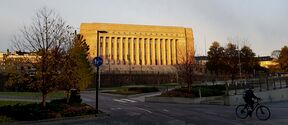Bacterial bandages and recycled fibres: Aalto brings a materials revolution to Slush

Ioncell. Photo: Aalto University / Aleksi Poutanen
Aalto University will introduce ten fascinating projects in materials research at Slush. The projects we’re presenting include long-term novel research and projects nearing commercialisation.
The use of biomass is a unifying factor for many projects. Biomaterials research has long been one of the strengths of Aalto University, and the FinnCERES innovation ecosystem accelerates research even further. The objective of FinnCERES, launched with partner VTT Technical Research Centre of Finland, is to generate 300 inventions in the bioeconomy sector, 80 new products or services, and 8 startups in the next eight years.
Calculations by VTT show that the value of forest and agricultural biomass in Finland can be doubled by 2050 if it is used to manufacture products of high added value. For example, the global demand for textile fibres is growing at an annual rate of 3%, and companies are fervently looking for new, ecological alternatives for cotton and polyester.
At Slush, Aalto researchers are presenting a technology called Ioncell, which can be used for manufacturing high-quality textile fibres from wood as well as recycled materials. Aalto’s stand will also introduce environmentally friendly coatings made from lignin, which is a by-product of pulp and paper production. These lignin coatings make metals a hundred times more resistant to rust.

3D printed bone implants
Demand for solar energy is growing fast, spurring the development of a wide range of new materials. Many of these new materials are, however, either rare and expensive or harmful to the environment, restricting their use on a larger scale. Researchers at Aalto have already succeeded in replacing the platinum used in solar cells with charred biomass produced from industrial side streams. The research continues: in addition to wood, could other organic waste, such as fish scales, be used in manufacturing efficient cells?
Bacteria are some of the world's most durable organisms, and they can be harnessed to produce a variety of materials. One such material is bacterial cellulose: resistant to heat and chemicals, it is extremely durable.Bacterial cellulose is not harmful for living tissues, which makes it a promising material for various medical applications, such as wound-care products or for growing implants.
At Aalto’s stand you can also learn about natural dyes, 3D printed bone implants, the idea of a computer mimicking the human brain, and much more. At the same time, you can find out about startups at Aalto and our entrepreneurship activities.
We’re looking forward to seeing you at Aalto's stand at Slush!
Read more about our amazing projects at https://www.whatif.aalto.fi/
Enquiries:
Heidi Henrickson
Materials Platform Manager
heidi.henrickson@aalto.fi
More information
Read more news

Entrepreneurship offers women empowerment in late-stage careers
Launching their own venture offers older women a chance to turn their age into a competitive advantage, reveals new research.
Topics raised in the 2025 Learning Centre customer survey
Thank you to everyone who participated in the survey!
Aalto Stoa Archived
Aalto Stoa, the student-driven platform for Otaniemi campus design, has now been completed and archived for future reference.






